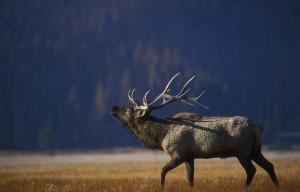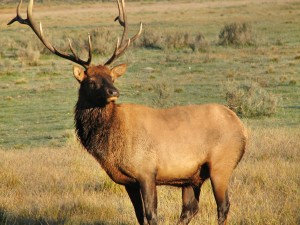Elk Rut
Caretaker Patty Reagin writes a monthly blog on the flora and fauna of the Wet Mountain Valley called “Spotted” for San Isabel Land Protection Trust (SILPT), the non-profit that holds the conservation easement for Humboldt Peak Ranch. This post is re-posted here courtesy of SILPT.
A couple of weeks ago while letting our dog out for her before-bed bathroom break, I was standing in the front yard taking in the glory of the Milky Way spanning the night sky when I heard a sound I hadn’t heard before. A bit eerie (particularly in the dark), it took me a minute to realize I was listening to one of the quintessential sounds of Fall in the Colorado high country– an elk bugle.

Where we now live there is a resident elk herd. We see them sometimes in the distance, ghosting through the forest when we’re out gathering logs for firewood or walking the dogs. In their silence it’s easy to miss them unless we’re paying attention. We may hear a twig snap, or catch a flash of tan moving through a shaft of sunlight. But as the rut (elk mating season) started to gain momentum, their presence became hard to miss. The bugling that started out faint and only audible a few times per night steadily increased until it often sounded as if the restless bulls were just outside our window calling challenges to each other and doing their best to attract the females of the species.
Elk rut can begin as early as mid-August, and last as late as mid-October. While during much of the year, cows, calves and yearlings live together in herds as bulls spend their time either alone or in bachelor bands, during rut the loose ties among the bulls dissolve and they part ways. The luckier bulls form harems consisting of one, possibly two, mature bulls and a lot of cows and calves. The less lucky bulls spend their time trying to steal a cow to mate with on the sly.
Around sunset one evening last week as we drove out to feed the horses, a large harem watched us from the hay field. A very impressive lone bull stood guard, gauging the likelihood of us trying to come between him and his breeding imperative. While elk are generally more interested in running away from us humans then charging, all that changes during elk rut – a fact we were very aware of as we kept our distance and a wary eye on his demeanor.
The diversity of wildlife here in the Valley is always a delight, and sometimes it’s easy to forget the life is wild. Sitting in our little open-to-the-air Mule, I kept thinking of all those YouTube videos showing cars full of gawking tourists in Estes Park or Yellowstone getting too close to a rutting bull and being attacked, a fate I wasn’t interested in sharing.
But during the frenzy of rutting season, it’s still easy to feel a little sorry for the bulls. With the very high possibility of losing harem cows to other bulls, or not getting a cow to mate with at all, the bulls don’t get a lot of sleep and rarely eat as they keep a constant lookout. By the end they look as ragged and exhausted as they probably feel. We’re still hearing bugling a few times every night, but things are winding down. Soon the cows will be carrying next springs’ calves, the bulls will have left the harems, and as the snow begins to fly the boys will be back together again, all animosity forgotten.